Quentin Surname Ancestry ResultsOur indexes 1000-1999 include entries for the spelling 'quentin'. In the period you have requested, we have the following 36 records (displaying 11 to 20): Single Surname Subscription | | | Buying all 36 results of this search individually would cost £176.00. But you can have free access to all 36 records for a year, to view, to save and print, for £100. Save £76.00. More... |
These sample scans are from the original record. You will get scans of the full pages or articles where the surname you searched for has been found. Your web browser may prevent the sample windows from opening; in this case please change your browser settings to allow pop-up windows from this site. The household of Queen Victoria
(1841)
The Royal Kalendar lists the staff of the royal household: the Lord Chamberlain's Department (including the Keeper of her Majesty's Privy Purse, the Master of the Ceremonies, the Mistress of the Robes, the Ladies of the Bedchamber, Maids of Honour, Bedchamber Women, Lords in Waiting, Grooms in Waiting, Gentlemen Ushers, Quarterly Waiters in Ordinary and Grooms); the Office of the Robes (including Pages, Gentlemen of the Privy Chamber and Sergeants at Arms); the Band of Music; Medical Department; Chapel Royal; Lord Steward's Department (including the Board of Green Cloth, Ewry, Wine and Beer Cellars, Kitchen, Confectionery, Silver Pantry, Coal Yard, Servants Hall, State Porters, Court of Marshalsea, Marshalsea Prison, Almonry, and Gardners; Gentlemen-at-Arms; the Queen's Stables, the Master of the Horse's Department, and the Royal Hunt.QUENTIN. Cost: £6.00.  | Sample scan, click to enlarge

|  Persons of standing recommending London police recruits
(1830-1842) Persons of standing recommending London police recruits
(1830-1842)
The Metropolitan Police Register of Joiners (MEPO 333/4) lists policemen joining the force through to 31 December 1842 (to warrant number 19892). The register is alphabetical, in so far as the recruits are listed chronologically grouped under first letter of surname. It is evidently a continuation of a similar earlier register, not closed until its alphabetical sections were filled: consequently, there are no entries in this register for the initial letters N, O, Q, U, V, X, Y or Z; and the sections of this register start at different dates - A 18 April 1840 (warrant number 16894); B 11 December 1830 (5570); C 7 September 1830 (4988); D 27 May 1833 (8445); E 15 December 1838 (14476); F 30 March 1832 (7372); G 1 December 1835 (11,184); H 25 April 1832 (7457); I and J 13 February 1837 (12449); K 2 January 1838 (13457); L 3 October 1834 (9905); M 15 November 1832 (7999); P 4 October 1831 (6869); R 4 September 1837 (13021); S 30 March 1835 (10366); T 6 April 1840 (16829); W 30 December 1833 (9096). The register gives Date of Appointment, Name, Number of Warrant, Cause of Removal from Force (resigned, dismissed, promoted or died), and Date of Removal. Those recruits not formerly in the police, the army, or some government department, were required to provide (normally) at least two letters of recommendation from persons of standing, and details of these are entered on the facing pages: the names in these are indexed here (the police recruits are indexed separately and not included here). Recruits transferred from other forces or rejoining the force did not normally need recommendations - in the latter case, former warrant numbers are given - but some recommendations are from police inspectors, even other constables. Recruits coming from the army sometimes have general military certificates of good conduct, but most often have a letter from their former commanding officer; recruits recommended by government departments (most often the Home Office) similarly have letters from the head of department. But the great majority of the names and addresses in these pages are of respectable citizens having some sort of personal acquaintance with the recruit. Where more than two recommendations were provided, the clerk would only record one or two, with the words 'and others'. Tradesmen are sometimes identified as such by their occupations; there are some gentry. Although the great bulk of these names are from London and the home counties, a scattering are from further afield throughout Britain and Ireland. QUENTIN. Cost: £8.00.  | Sample scan, click to enlarge

| Norwich Dyers and Dressers
(1842)
The Norwich Guide and Directory 'being an Historical and Topographical Description of the City and its Hamlets; with an Account of the Public Charities, and Correct Lists of the Various Professions, Trades, Public Institutions, Churches, Chapels, Municipal and other Offices; also the Names and Residences of the Nobility, Clergy, and Gentry; together with the Hours of the Arrival and Departure of the Mail and Post Coaches, Vans, Carriers, Steam and Sailing Vessels, and all Conveyances to London and the various Parts of the County of Norfolk', by G. K. Blyth, was published in 1842, and includes detailed lists of local institutions, trades and professions.QUENTIN. Cost: £6.00.  | Sample scan, click to enlarge
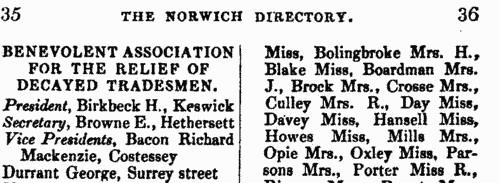
| Norwich Greengrocers
(1842)
The Norwich Guide and Directory 'being an Historical and Topographical Description of the City and its Hamlets; with an Account of the Public Charities, and Correct Lists of the Various Professions, Trades, Public Institutions, Churches, Chapels, Municipal and other Offices; also the Names and Residences of the Nobility, Clergy, and Gentry; together with the Hours of the Arrival and Departure of the Mail and Post Coaches, Vans, Carriers, Steam and Sailing Vessels, and all Conveyances to London and the various Parts of the County of Norfolk', by G. K. Blyth, was published in 1842, and includes detailed lists of local institutions, trades and professions.QUENTIN. Cost: £6.00.  | Sample scan, click to enlarge
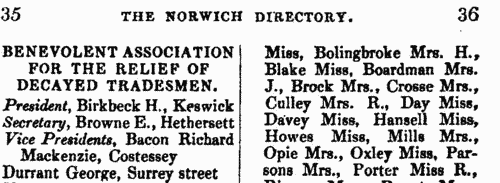
| Norwich Mahogany Merchants
(1842)
The Norwich Guide and Directory 'being an Historical and Topographical Description of the City and its Hamlets; with an Account of the Public Charities, and Correct Lists of the Various Professions, Trades, Public Institutions, Churches, Chapels, Municipal and other Offices; also the Names and Residences of the Nobility, Clergy, and Gentry; together with the Hours of the Arrival and Departure of the Mail and Post Coaches, Vans, Carriers, Steam and Sailing Vessels, and all Conveyances to London and the various Parts of the County of Norfolk', by G. K. Blyth, was published in 1842, and includes detailed lists of local institutions, trades and professions.QUENTIN. Cost: £6.00.  | Sample scan, click to enlarge
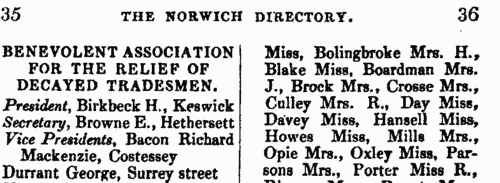
| Deaths, Marriages, News and Promotions
(1845)
Death notices and obituaries, marriage and birth notices, civil and military promotions, clerical preferments and domestic occurrences, as reported in the Gentleman's Magazine. Mostly from England and Wales, but items from Ireland, Scotland and abroad.
QUENTIN. Cost: £4.00.  | Sample scan, click to enlarge

| The Edinburgh Gazette
(1846)
The Edinburgh Gazette is the official publication in which various Scottish legal notices are issued, as well as promotions and casualty lists for the British army as a whole, and brief lists of English bankrupts. The key source for tracing details of Scottish bankruptcies, insolvencies, and dissolutions of business partnerships.QUENTIN. Cost: £6.00.  | Sample scan, click to enlarge
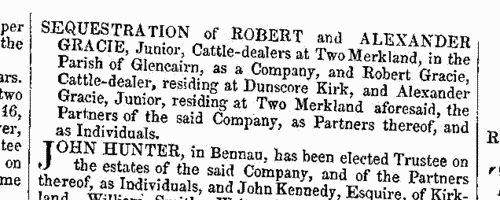
| Deaths, Marriages, News and Promotions
(1848)
Death notices and obituaries, marriage and birth notices, civil and military promotions, clerical preferments and domestic occurrences, as reported in the Gentleman's Magazine. Mostly from England and Wales, but items from Ireland, Scotland and abroad. July to December 1848.QUENTIN. Cost: £4.00.  | Sample scan, click to enlarge

| Boys entering Brighton College
(1853)
This edition of the Brighton College Register was published in 1922. The plan of the publication was to list boys by year or, later, term of entry. Each name is assigned a sequential number, 5000 boys, in all, being recorded. Full name is given (surname first, in bold); year of birth; year of leaving; and then (wherever the compiler had such information) a short biography, ending with date of death, where known.QUENTIN. Cost: £4.00.  | Sample scan, click to enlarge
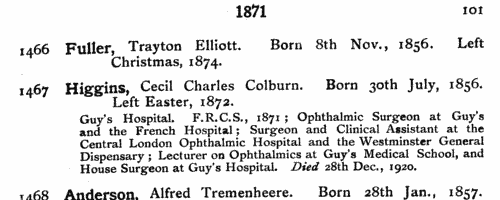
| British Army Officers
(1853)
The 14th volume of the New Annual Army List, for 1853, corrected to 30 December 1852, was published by Major H. G. Hart of the 49th Regiment. It contained 'the dates of commissions, and a statement of the war services and wounds of nearly every officer in the Army, Ordnance and Marines'. The first section, pages 1 to 111, lists officers of the rank of major and above in order of rank and precedence; officers with local rank (112-114); Yeomen of the Guard (115); the Honourable Corps of Gentlemen-at-Arms (116); Headquarters Staff (117); and then (as in the scan) all the regiments and units in order of precedence, giving any regimental honours, with all the officers by rank, and details of postings, facings and agents (118-336). A long section (337-426) then lists officers on the retired full pay and half-pay, including the Royal Regiment of Artillery, Corps of Royal Engineers, Royal Marines and military departments. Then there are lists of officers in the Commissariat Department, the Medical Department, Veterinary Surgeons and the Chaplains Department. A section of Officers on the Foreign Half-Pay gives lists for the German Legion and Miscellaneous Corps (Brunswick Cavalry, Brunswick Infantry, Chasseurs Britanniques, Royal Corsican Rangers, Dillon's Regiment, Greek Light Infantry, Royal Malta Regiment, Meuron's Regiment, Roll's Regiment, Sicilian Regiment, Watteville's Regiment, York Light Infantry Volunteers, the Foreign Veteran Battalion, and the Foreign Corps of Waggoners). After lists of officers in garrisons and military establishments, there are sections listing officers holding Gold Decorations for their parts in various important actions and other British decorations, and those holding medals bestowed by foreign powers. QUENTIN. Cost: £4.00.  | Sample scan, click to enlarge
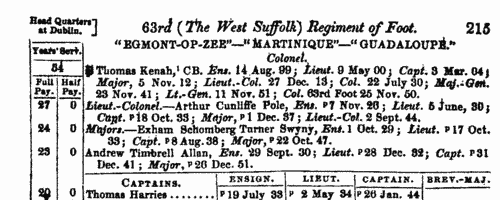
|
Research your ancestry, family history, genealogy and one-name study by direct access to original records and archives indexed by surname.
|













